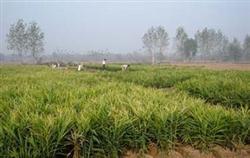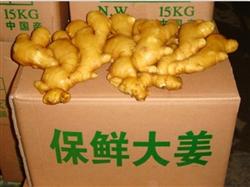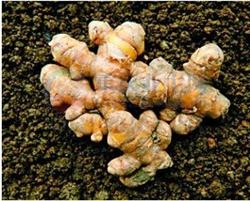Formula fertilization technique for high yield of ginger

Ginger has a long growing period and needs a lot of fertilizer. under the condition of medium fertility, it generally produces 2500 kg of ginger per mu, which requires 25 kg of nitrogen, 10 kg of phosphorus (P2O5) and 30 kg of potassium (K2O). The absorption ratio of nitrogen, phosphorus and potassium is 11 ∶ 1 ∶ 16 or 1 ∶ 0.5 ∶ 2, as well as calcium, magnesium, boron, zinc, iron and other trace elements. Due to the different demand for nutrients in different periods, the yield and quality can be improved by formula fertilization. 1. The root system of ginger with sufficient base fertilizer is weak and its distribution is shallow, and re-application of base fertilizer is the key to high yield. Before soil preparation, 2500-5000 kg of high-quality rotten chicken manure was applied per mu, and ploughing after fertilization, the whole border was 1.2 meters wide, 30 cm wide and 20 cm deep, with 3 rows of ginger; or 2 cm 2.4 meters wide, 40 cm wide and 40 cm deep, and 4 rows of ginger were planted. Before sowing, 75100kg cake fertilizer and 1520kg ternary compound fertilizer were used per mu, and after crushing, they were concentrated in the sowing ditch and mixed with the soil, then watered and sowed. In zinc-deficient and boron-deficient ginger fields, zinc sulfate 1kg / mu and borax 0.5kg / mu can be evenly mixed with fine soil or organic fertilizer, applied in sowing ditch and mixed with soil. two。 Suitable topdressing ginger generally needs topdressing 2 times during the growth period, and zinc and boron deficient ginger fields should be sprayed with 0.05% 0.1% zinc and boron fertilizer at seedling stage, rosette stage and rhizome expansion stage respectively. ① applied "strong seedling fertilizer" lightly for the first time. From spreading leaves to having two larger lateral branches is the seedling stage (i.e. "three branches"), which takes 65 to 75 days. The plant growth is small in the seedling stage, but the growth period is long, and the first topdressing is usually carried out when the seedling height is 25cm to 30cm and has 1 to 2 branches. Topdressing is mainly nitrogen fertilizer, 1000-1500 kg per mu of rotten acquaintance feces or 4-5 kg of urea, ditched or watered. If the sowing date is too early and the seedling stage is longer, it can be fertilized for 2 or 3 times with watering, and the amount of fertilization is the same as above. ② re-applied "fork fertilizer" (or "branch fertilizer", "turning fertilizer", etc.) for the second time. Before and after the Beginning of Autumn in late July to early August, ginger seedlings were in the period of "three branches", and the demand for fertilizer and water increased, so topdressing should be combined with weeding in ginger fields. Generally, cake fertilizer or farm fertilizer is combined with quick-acting chemical fertilizer, 1500kg / mu of mature human feces and 25kg / mu of ternary compound fertilizer are applied, and a fertilizer ditch is opened 15-20cm from the base of the plant on one side of the ginger seedling, and the fertilizer is sprinkled and mixed with the soil, and then covered with soil to seal the ditch, cultivate ridges, and finally pour water through. If the weather is dry, irrigate every 4-6 days and always keep the soil relative humidity at 75%-80%. Soil was cultivated at the base of the plant for 3 times to make the rhizome expand. When the ginger seedlings grow to 19.8 to 23.1 cm high, the hidden buds from the ginger mother should be removed in time to avoid wasting nutrients. When the ginger seedlings grow to 35-45 cm high, one or two buds will grow from both sides of the ginger mother, and these buds should be preserved. ③ skillfully applied "expansion fertilizer" (or "strong ginger fertilizer" and "supplementary fertilizer") for the third time. From mid-late August to early September, when ginger seedlings have 6-8 branches, the third topdressing can be carried out as appropriate. Generally, 200 kilograms of rotten cake fertilizer or 25 kilograms of ternary compound fertilizer are applied per mu. While fertilizing, furrow irrigation or watering is used to prevent root burning. Water should be irrigated every 10 days or so in dry weather, and should be watered in the morning and evening in high temperature season. After rainstorm, waterlogging should be drained immediately to make the furrow smooth. For ginger fields with weak or general growth and low soil fertility, quick-acting chemical fertilizers, especially potassium and nitrogen fertilizers, should be applied, while for ginger fields with good soil fertility and vigorous plant growth, little or no nitrogen fertilizer should be applied. Ginger likes to be cool and humid, can not bear high temperature and strong light, and should build a shed to shade when the weather is hot. In the first and middle of August, the top of the ginger plant should be knocked off, once every 7-8 days, 2-3 times in a row; ginger branches and leaves are already luxuriant in late August. The ginger shed can be removed at this time. Pour the last water 3 days before harvest, so that the ginger pieces can carry wet soil during harvest, which is beneficial to storage. It is usually harvested before the arrival of the first frost in mid-late October.
- Prev

Several methods of preventing ginger heart-drilling disease
Ginger contains volatile ginger oil ketone, gingerol and spicy ingredients, which can form aromatic and spicy ginger oil. Ginger oil stimulates appetite and helps digestion. Therefore, ginger is a good seasoning. In terms of health care, ginger also has the effects of dispelling cold, sweating, expelling wind and resolving phlegm. Su Mei ginger processed from ginger is very popular with people.
- Next

Comprehensive Control techniques of Ginger Rot
1. Choose disease-free ginger seeds and seed ginger for disinfection. Leave seeds from disease-free areas or select disease-free ginger, soak the seeds before sowing with 50% carbendazim wettable powder for 6 hours, or soak the seeds with 2000 times of neophytin for 24 hours. two。 Ginger selection and disinfection. The pathogen can survive in the soil for more than 2 years.
Related
- Where is it suitable to grow horseradish in China? it is expected to see the middle altitude horseradish in Alishan.
- How to prevent tomato virus disease reasonably? (Control methods included)
- Many people like to plant towel gourd on the balcony. What are the main points of this method and management?
- What crops can chili peppers be mixed with?
- Fertilization techniques and matters needing attention in Tomato
- What are the grafting techniques for peach seedlings in spring?
- Harm and control methods of root swelling disease of Chinese cabbage
- What are the pests of sweet potatoes? How to prevent and cure it?
- Symptoms, causes and Control methods of navel Rot in Tomato
- The cause of "Cucumber rotten bibcock" in Farmers' planting Cucumber and its Control Plan

